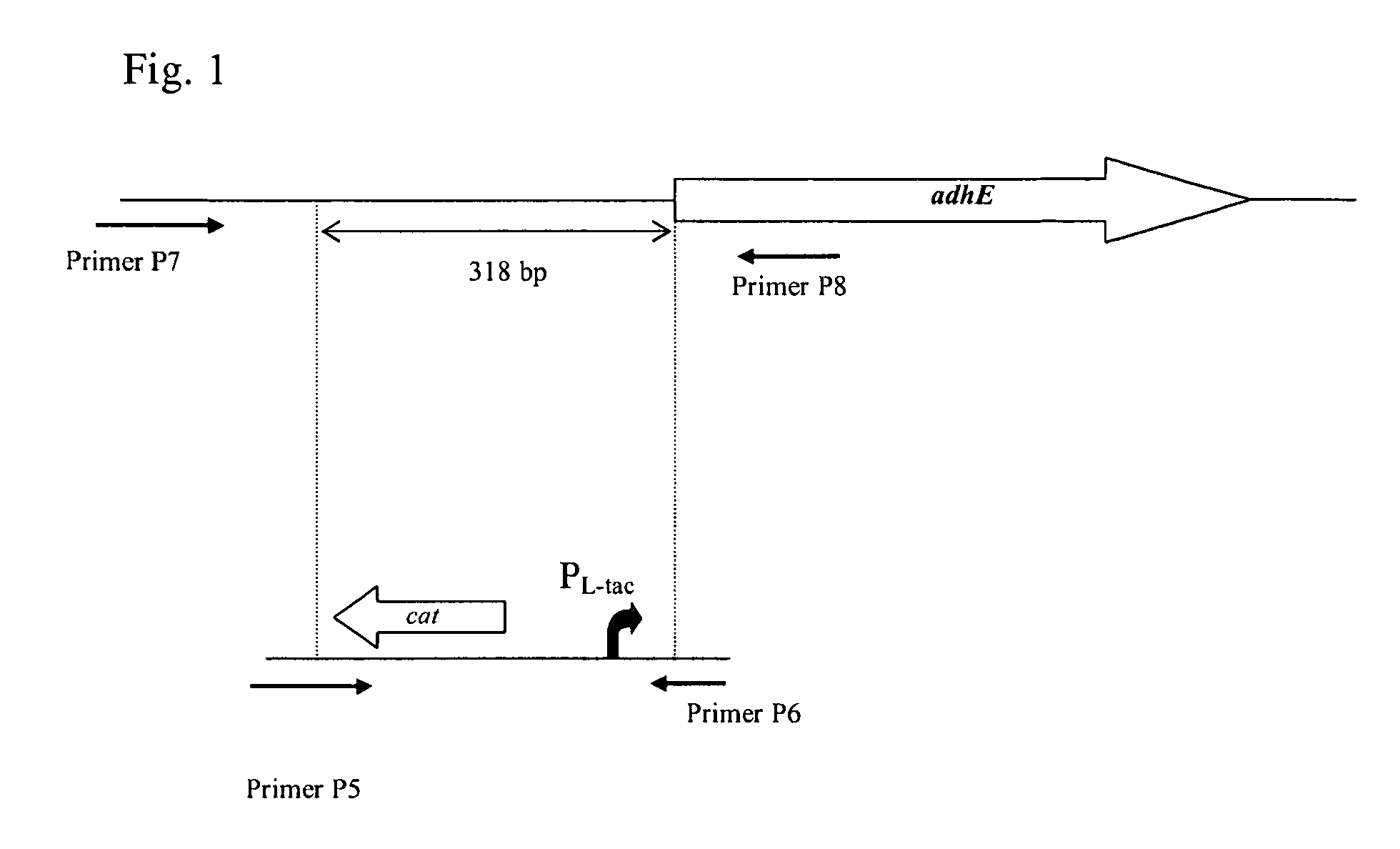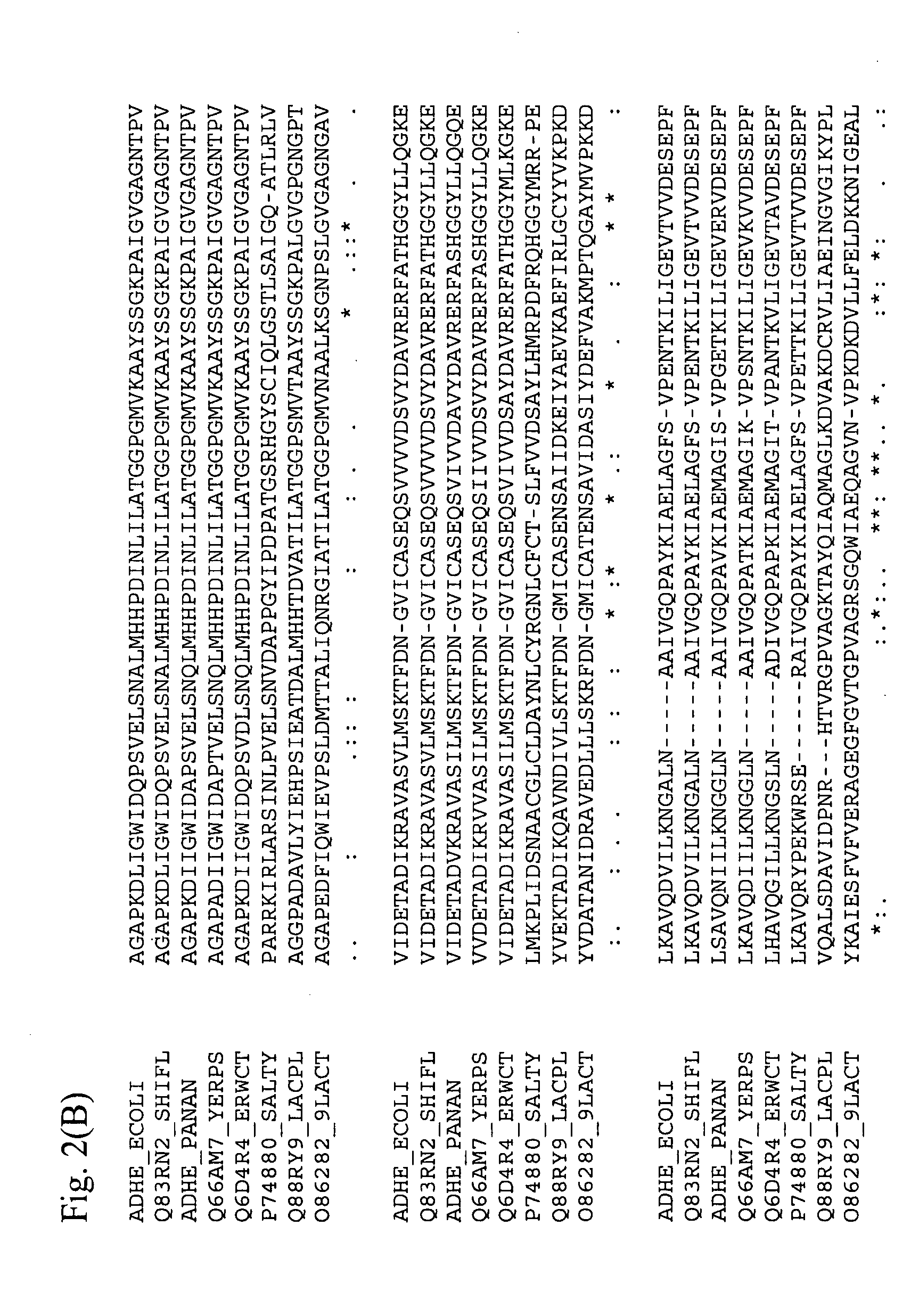Method for producing an l-amino acid using a bacterium of the enterobacteriaceae family
a technology of enterobacteriaceae and l-amino acid, which is applied in the field of microorganisms, bacteria, microorganisms, etc., can solve the problems of acetyl-coa formation rate limitation for wild-type adhe, insufficient carbon source access of highly productive strains, and no reports to date of using a bacterium of the enterobacteriaceae family, etc., to achieve the effect of enhancing the productivity
- Summary
- Abstract
- Description
- Claims
- Application Information
AI Technical Summary
Benefits of technology
Problems solved by technology
Method used
Image
Examples
example 1
Preparation of E. Coli MG1655 Δtdh, rhtA*
[0167]The L-threonine producing E. coli strain MG1655 Atdh, rhtA* (pVIC40) was constructed by inactivation of the native tdh gene encoding threonine dehydrogenase in E. coli MG1655 (ATCC 700926) using the cat gene followed by introduction of an rhtA23 mutation (rhtA*) which confers resistance to high concentrations of threonine (>40 mg / ml) and homoserine (>5 mg / ml). Then, the resulting strain was transformed with plasmid pVIC40 from E. coli VKPM B-3996. The plasmid pVIC40 is described in detail in U.S. Pat. No. 5,705,371.
[0168]To replace the native tdh gene, a DNA fragment carrying the chloramphenicol resistance marker (CmR) encoded by the cat gene was integrated into the chromosome of E. coli MG1655 in place of the native gene by the method described by Datsenko K. A. and Wanner B. L. (Proc. Natl. Acad. Sci. USA, 2000, 97, 6640-6645) which is also called “Red-mediated integration” and / or “Red-driven integration”. The recombinant plasmid pKD4...
example 2
Construction of E. Coli MG1655::PL-tacadhE
[0174]E. coli MG1655::PL-tacadh was obtained by replacement of the native promoter region of the adhE gene in the strain MG1655 by PL-tac promoter.
[0175]To replace the native promoter region of the adhE gene, the DNA fragment carrying a PL-tac promoter and chloramphenicol resistance marker (CmR) encoded by the cat gene was integrated into the chromosome of E. coli MG1655 in the place of the native promoter region by the method described by Datsenko K. A. and Wanner B. L. (Proc. Natl. Acad. Sci. USA, 2000, 97, 6640-6645), which is also called “Red-mediated integration” and / or “Red-driven integration”.
[0176]A fragment containing the PL-tac promoter and the cat gene was obtained by PCR using chromosomal DNA of E. coli MG1655PL-tacxylE (WO2006 / 043730) as a template. The nucleotide sequence of the PL-tac promoter is presented in the Sequence listing (SEQ ID NO: 7). Primers P5 (SEQ ID NO: 8) and P6 (SEQ ID NO: 9) were used for PCR amplification. P...
example 3
Construction of E. Coli MG1655Δtdh, rhtA*, PL-tacadhE
[0182]E. coli MG1655Δtdh, rhtA*, PL-tacadhE was obtained by transduction of the PL-tac promoter from the strain MG1655::PL-tacadhE into strain MG1655Δtdh, rhtA*.
[0183]The strain MG1655Δtdh, rhtA* was infected with phage P1vir grown on the donor strain MG1655::PL-tacadhE, and the strain MG1655Δtdh, rhtA*, PL-tacadhE was obtained. This strain was checked for growth on M9 plates with 2% ethanol as the sole carbon source. The growth rate was the same as for the strain MG1655::PL-tacadhE.
PUM
| Property | Measurement | Unit |
|---|---|---|
| temperature | aaaaa | aaaaa |
| temperature | aaaaa | aaaaa |
| concentrations | aaaaa | aaaaa |
Abstract
Description
Claims
Application Information
 Login to View More
Login to View More - R&D
- Intellectual Property
- Life Sciences
- Materials
- Tech Scout
- Unparalleled Data Quality
- Higher Quality Content
- 60% Fewer Hallucinations
Browse by: Latest US Patents, China's latest patents, Technical Efficacy Thesaurus, Application Domain, Technology Topic, Popular Technical Reports.
© 2025 PatSnap. All rights reserved.Legal|Privacy policy|Modern Slavery Act Transparency Statement|Sitemap|About US| Contact US: help@patsnap.com



